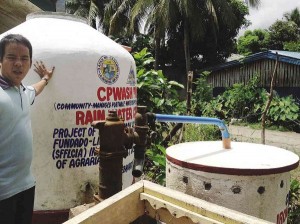Farmers redesign for potable water, gas

RAIN COLLECTOR Alger Abarientos, San Francisco Elementary School principal, shows the route that rainwater takes from the gutter of the school building to the CPWash rain collector where it undergoes a purification process to be turned into potable drinking water. IAN TADURAN
Hog raiser Rudy Nuñez smiled as he turned the dial on his stove to bring the machine to life with a sudden burst of flames. He was not going to cook anything, he was just showing off.
Yet, he was not mindful of the waste of energy because he had it for free, courtesy of his pigs.
Nuñez was awarded the biogas digester septic tank as part of the Community-Managed Potable Water Supply, Sanitation and Hygiene (CPWash) facility, an initiative of the San Francisco Fundado-Linaga-Canaman Irrigators Association (SFFLCIA) and the Department of Agrarian Reform (DAR).
CPWash technology seeks to provide potable water by making use of readily available sources of water such as rainwater to agrarian reform beneficiaries. So far, the DAR has installed 20 iron removal filters, 70 biosand filters, nine rainwater collectors and 22 biogas digesters in 140 households across Bicol.
Farmer-members of the SFFLCIA in Barangay (village) San Francisco in Canaman, Camarines Sur, were trained as “para-engineers” to handle the facility for the benefit of their community and the environment.
Article continues after this advertisementApart from the septic tank, the project has a water filtration and purification system installed at San Francisco Elementary School to supply potable water to pupils, teachers and community members.
Article continues after this advertisementSalty taste
It is common for drinking water in Canaman to suddenly taste like seawater during high tide, said Bernardo Bandola, a resident. The third-class municipality (annual income: P35 million-P45 million) is at the confluence of the Bicol River and the San Miguel Bay.
The people usually buy water for P80 per plastic container from lorries of the Pili Water District, Bandola said. Each container has 24 liters of clean water.
Not all households in San Francisco have access to potable water, said Alger T. Abarientos, the principal of San Francisco Elementary School. “Only several families here have water pumps,” he said. “They do not even have clean water all the time.”
Installed in the school in June, the CPWash facility has a rainwater collector, iron removal filters and biosand filters that purify rainwater and water collected from a nearby well.
Its water is so clean that Abarientos even uses it for cooking rice and drinking. It is odorless, tasteless and as clear as the bottled mineral water sold in markets, said the SFFLCIA president, Nicanor de Castro.
DOH tests
Water samples taken from CPWash were submitted by the DAR to the Department of Health (DOH) in June to determine if these were safe for drinking, De Castro said. These passed the analysis test conducted by the DOH.
Members of the SFFLCIA upgraded the DAR’s original community potable water project designs after undergoing a nine-day training as para-engineers in March. The association is among the many beneficiaries of CPWash in at least 16 municipalities in Albay, Camarines Norte, Camarines Sur and Masbate.
Carmelita Estefani, DAR development facilitator for Canaman, said the trainees combined the iron removal filters and biosand filters in the original CPWash design.
They also improved on the biogas digester so that water collected with the pig waste would not overflow, she said.
Replicate
In a media statement issued earlier, De Castro explained that the farmers replaced the hollow blocks with polyvinyl chloride (PVC) pipes for stronger support and prevention of bacterial growth in the digester. They reduced the culvert filtration holes from 12 to six to minimize possibility of insects passing through the holes, he said.
Water outlets in the filtration and purification system were reduced from 12 to only one to ensure that water overflowing from the unit will not blend or mix with the filtered one.
De Castro said in a phone interview that the DAR was planning to replicate the new design in other municipalities in Camarines Sur. He said training was being conducted among irrigators and farmers in Garchitorena town, also in the province, until August to help them build their own CPWash facility.
Nuñez’s has about 10 pigs whose waste goes directly to the upgraded septic tank which, in turn, generates gas. The biogas digester transforms pig waste into energy that he uses as substitute for liquefied petroleum gas (LPG) and other fossil fuels to save on money and the environment.
Biogas facility
Since receiving the biogas facility this month, the hog raiser has to wait only 15 days to be able to use the biogas emitted by the accumulated pig waste. Now, he can save P700 to P1,000 every month.
Neighbors used to complain of the stink from hog waste. With the biogas digester septic tank, the foul smell and sanitation is no longer a problem.
“I am glad that this facility was given free to me because if I would want this built on my own, I would have to spend around P35,000 according to an estimate done by the farmers who built it for us,” Nuñez said.